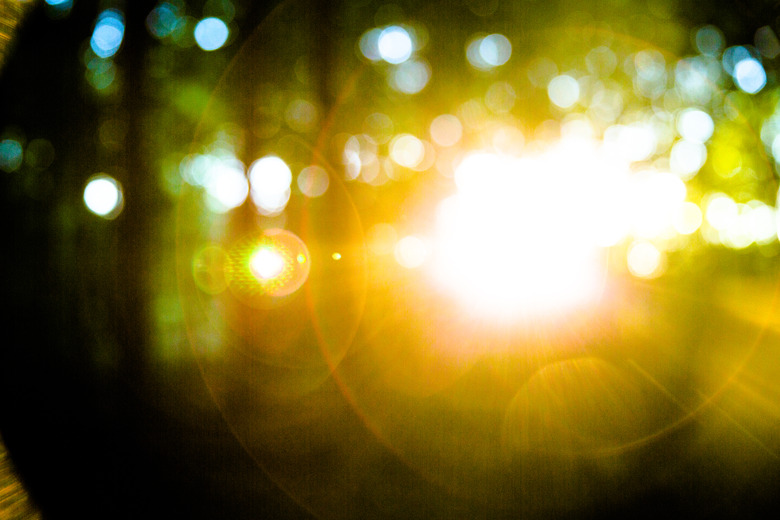What Are Light Independent Reactions?
Plant photosynthesis can be divided into two parts. The first part requires light to change light energy to chemical energy, and its chemical reactions are called light-dependent reactions. The second part, which uses the chemical energy created by the first part to produce plant carbohydrates for plant food, is made up of light-independent reactions. The light-independent reactions are also called the Calvin cycle, after chemist Melvin C. Calvin who won the Nobel prize in chemistry in 1961 after identifying the process.
TL;DR (Too Long; Didn't Read)
The light-independent reactions of photosynthesis are the four reactions that take place in the later part of the photosynthesis process. Also known as the Calvin cycle, the four steps of the light-independent or dark reactions are carbon fixation, reduction, carbohydrate formation and regeneration of the initial enzymes. While known as the dark reactions because they don't need light to proceed, the reactions take place during the day at the same time as the light-dependent reactions because the dark reactions need the chemical products from the light-dependent reactions as reactants for the four steps.
Overview of the Calvin Cycle
Overview of the Calvin Cycle
The Calvin cycle uses the chemicals produced during the light-dependent reactions to fix carbon dioxide and produce the carbohydrates plants need to survive. Overall, the precursor chemicals containing hydrogen from the first stage of photosynthesis and carbon dioxide are changed to carbohydrates.
In the light-dependent reactions, light is absorbed and the energy is used to split water molecules. The resulting hydrogen ions and electrons are transferred to chemical nicotinamide adenine dinucleotide phosphate (NADP+) to produce reduced nicotinamide adenine dinucleotide phosphate (NADPH) by adding two electrons and a hydrogen ion. At the same time, the chemical adenosine diphosphate (ADP) is changed to adenosine triphosphate (ATP) by adding a phosphate group. The new chemicals are used to store the energy absorbed from light and make it available for the Calvin cycle.
The Calvin cycle uses the hydrogen from NADPH, the carbon from carbon dioxide and energy from ATP to produce the carbohydrates that the plant needs. During this process the NADPH and the ATP are changed back to NADP+ and ADP so that they are again available for additional light-dependent reactions.
Calvin Cycle Reactants and Products
Calvin Cycle Reactants and Products
The Calvin cycle takes place within the chloroplasts of plant cells. Each cell has several chloroplasts, and the cells containing them form the leaves of the plant. Inside the chloroplasts, the Calvin cycle reactions take place in the stroma. The reactants CO2, ATP and NADPH initiate the four-step reactions that make up the Calvin cycle.
The first step fixes carbon from carbon dioxide in the air. Carbon atoms are attached to an intermediate sugar molecule. In the second step, a phosphate group from ATP is transferred to an intermediate enzyme, and electrons from NADPH are used to reduce the intermediate sugar from step 1. In the third step, the intermediate sugar reacts with the intermediate enzyme to form glucose, the basic carbohydrate plants can use as food. In the fourth step, the original chemicals needed for the reaction are regenerated. The reaction products are glucose, ADP and NADP+. The latter two are used again in light-dependent reactions.
While the Calvin cycle reactions can take place in the absence of light, they are in fact light dependent in plants and take place during the day. This dependency comes from the required reactants ATP and NADPH, which are quickly used up by the Calvin cycle reactions. The reactants are replenished by the light-dependent reactions from the Calvin cycle products ADP and NADP+. The complete photosynthesis process relies on a coordinated functioning of both the light-dependent and dark reactions to produce carbohydrates from light, water and carbon dioxide.
References
Cite This Article
MLA
Markgraf, Bert. "What Are Light Independent Reactions?" sciencing.com, https://www.sciencing.com/what-are-light-independent-reactions-13712141/. 12 May 2018.
APA
Markgraf, Bert. (2018, May 12). What Are Light Independent Reactions?. sciencing.com. Retrieved from https://www.sciencing.com/what-are-light-independent-reactions-13712141/
Chicago
Markgraf, Bert. What Are Light Independent Reactions? last modified August 30, 2022. https://www.sciencing.com/what-are-light-independent-reactions-13712141/
